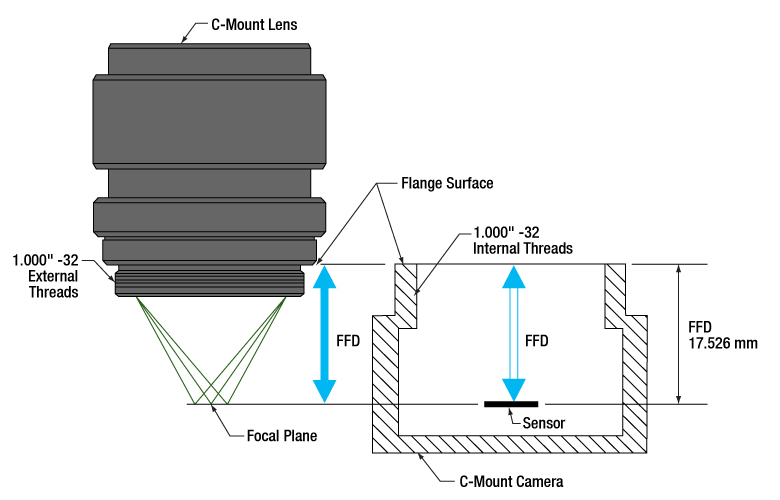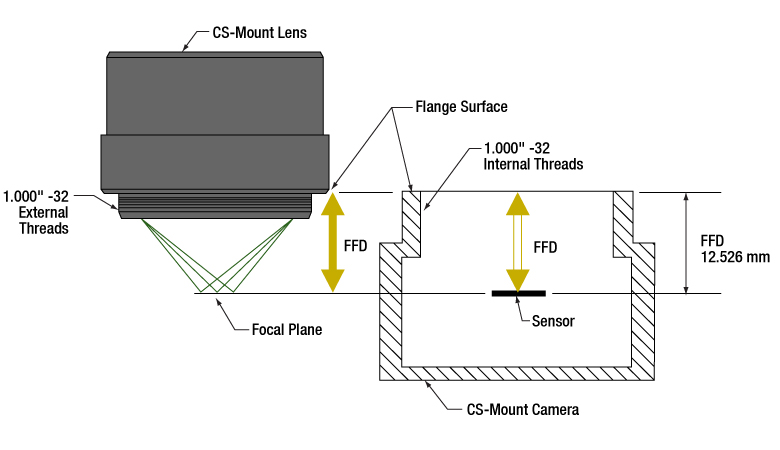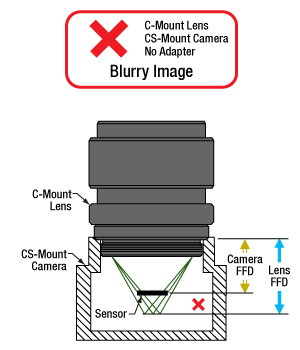M12 Mount (S Mount ) Vs. C Mount Vs. CS Mount
M12 Mount
The M12 mount refers to a standardized lens mount commonly used in the field of digital imaging. It is a small form factor mount primarily used in compact cameras, webcams, and other small electronic devices that require interchangeable lenses.
The M12 mount has a flange focal distance of 12mm, which is the distance between the mounting flange (the metal ring that attaches the lens to the camera) and the image sensor. This short distance allows for the use of small and lightweight lenses, making it suitable for compact and portable camera systems.

The M12 mount typically uses a threaded connection to secure the lens to the camera body. The lens is screwed onto the camera, and the threads ensure a secure and stable attachment. This type of mount is known for its simplicity and ease of use.
One advantage of the M12 mount is its wide compatibility with various lens types. Many lens manufacturers produce M12 lenses, offering a range of focal lengths and aperture options to suit different imaging needs. These lenses are typically designed for use with small image sensors found in compact cameras, surveillance systems, and other devices.
C mount
The C mount is a standardized lens mount used in the field of professional video and cinema cameras. It was initially developed by Bell & Howell in the 1930s for 16mm film cameras and later adopted by other manufacturers.
The C mount has a flange focal distance of 17.526mm, which is the distance between the mounting flange and the image sensor or film plane. This short distance allows for flexibility in lens design and makes it compatible with a wide range of lenses, including both prime lenses and zoom lenses.

The C mount uses a threaded connection to attach the lens to the camera body. The lens is screwed onto the camera, and the threads ensure a secure and stable attachment. The mount has a 1-inch diameter (25.4mm), which makes it relatively small compared to other lens mounts used in larger camera systems.
One of the key advantages of the C mount is its versatility. It can accommodate various lens types, including 16mm film lenses, 1-inch format lenses, and smaller lenses designed for compact cameras. Additionally, with the use of adapters, it is possible to mount C mount lenses on other camera systems, expanding the range of available lenses.
The C mount has been widely used in the past for film cameras and is still utilized in modern digital cameras, particularly in the industrial and scientific imaging fields. However, in recent years, other lens mounts like the PL mount and EF mount have become more prevalent in professional cinema cameras due to their ability to handle larger sensors and heavier lenses.
Overall, the C mount remains an important and versatile lens mount, particularly in applications where compactness and flexibility are desired.
CS Mount
The CS mount is a standardized lens mount commonly used in the field of surveillance and security cameras. It is an extension of the C mount and is designed specifically for cameras with smaller image sensors.
The CS mount has the same flange focal distance as the C mount, which is 17.526mm. This means that CS mount lenses can be used on C mount cameras by utilizing a C-CS mount adapter, but C mount lenses cannot be directly mounted on CS mount cameras without an adapter due to the shorter flange focal distance of the CS mount.

The CS mount has a smaller back focal distance than the C mount, allowing for more space between the lens and the image sensor. This extra space is necessary to accommodate the smaller image sensors used in surveillance cameras. By moving the lens further away from the sensor, CS mount lenses are optimized for these smaller sensors and provide the appropriate focal length and coverage.
The CS mount uses a threaded connection, similar to the C mount, to attach the lens to the camera body. However, the thread diameter of the CS mount is smaller than that of the C mount, measuring 1/2 inch (12.5mm). This smaller size is another characteristic that distinguishes the CS mount from the C mount.
CS mount lenses are widely available and specifically designed for surveillance and security applications. They offer a variety of focal lengths and lens options to meet different surveillance needs, including wide-angle lenses, telephoto lenses, and varifocal lenses. These lenses are typically used in closed-circuit television (CCTV) systems, video surveillance cameras, and other security applications.
It’s important to note that CS mount lenses are not directly compatible with C mount cameras without an adapter. However, the reverse is possible, where C mount lenses can be used on CS mount cameras with the appropriate adapter.


